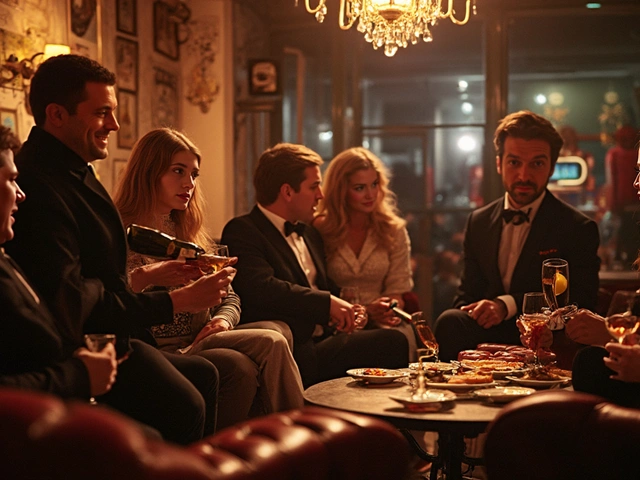Skip the lines of hype: behind every packed stadium or surprise small club gig, there's a backbone of information that keeps the music business moving. Pollstar isn't just industry gossip to most folks, but to promoters, agents, and venues, it's gold. If you've ever wondered how artists like Taylor Swift or BTS always seem to break new records or book the perfect venue, chances are someone’s been glued to Pollstar’s dashboards, tracking every ticket and trend. Think of Pollstar as the music industry's ultimate scoreboard—except, instead of just winners and losers, everyone from indie musicians to arena-filling icons checks the stats to make their next big move.
How Pollstar Powers the Concert Industry: The Data Engine Nobody Sees
Behind the scenes, Pollstar churns out stats and charts not just for fun, but because the business depends on them. Every ticket scanned, dollar made, and crowd gathered at a show gets wrapped up and tracked in Pollstar’s systems, which a small group of people in the know tap into every day.
Pollstar has been around since 1981, and over time, it’s become the live music equivalent of the Wall Street Journal. Promoters scout it before taking huge risks. Tour managers crunch the numbers here before mapping out the next global swing. Even artist managers sift through Pollstar’s venue directories and concert history before picking support acts or picking the next city. Say you’re a booking agent trying to pitch a mid-tier act into a famous midsize venue—bringing up recent Pollstar box office data on similar acts can seal the deal or kill it fast.
Here’s a table showing Pollstar’s biggest uses and who loves them:
| Who Uses Pollstar? | Main Use | Example |
|---|---|---|
| Promoters | See what tours are selling | Booking venues based on sales data |
| Agents | Venue and artist research | Matching acts to the right rooms |
| Managers | Tracking competition and trends | Planning announcements or routing tours |
| Venue Owners | Find booking opportunities | Attracting artists with audience data |
| Journalists/Fans | Comparing ticket sales, reporting | Ranking artists and tours |
Lots of people treat Pollstar like viewing the scoreboard at halftime—they’re not just gawking, they’re making decisions. So when a promoter drops $500,000 on a production, you can guess they’ve pored through Pollstar’s charts more than anyone stares at fantasy draft picks. If you see an artist jumping venues, changing setlists, or charging different prices from city to city, those changes are often based on Pollstar info.
For fans, Pollstar can be a goldmine or a mystery. Ever hear about ‘surprise’ sellouts or crazy record-breakers, and wonder where that info comes from? Odds are, it was reported to and crunched by Pollstar’s team, then delivered out for the world to marvel at.
Box Office Stats and Tour Charts: Tracking Who’s Hot (And Who’s Not)
If the concert world ran on rumors, nobody would make money. That’s where Pollstar’s charts—those famous Top 20 or Year-End reports—come in. Numbers don’t lie when they list the world’s biggest tours or the fastest-selling artists. Everyone wants that bragging right to top Pollstar’s charts. And for people making the business decisions, those numbers do more than stroke egos—they drive strategy.
Let’s get specific: Pollstar gathers data directly from venues and promoters, including ticket prices, attendance, and gross revenue (meaning total box office money), then verifies and compiles all of it. Want to know how many people packed into Bad Bunny’s last tour, or how much those Taylor Swift Eras Tour tickets brought in? Pollstar is basically the only place with the official, reliable answer.
Here’s some wild data from their public lists. In 2023, Taylor Swift’s Eras Tour grossed nearly $1.04 billion, the highest single-year total for a tour ever tracked by Pollstar. That’s not fluff—that’s straight from the box office numbers submitted by venues. Pollstar’s 2024 Mid-Year Top 100 Worldwide Tours showed Ed Sheeran and Beyoncé right behind, with figures regular fans only dream about. Even more, you can compare median ticket prices, see how different regions sell out faster, and watch trends (like the resurgence of stadium shows) shift in real time.
Industry folks obsess over ‘per show’ numbers—the average ticket price, the number of tickets moved, and the money brought in. Here’s an example table from Pollstar’s charts:
| Artist/Tour | Gross Revenue (USD) | Tickets Sold | Average Ticket Price |
|---|---|---|---|
| Taylor Swift (Eras 2023) | 1,040,000,000 | 4,350,000 | ~$239 |
| Ed Sheeran (2024) | 389,000,000 | 2,200,000 | ~$177 |
| Beyoncé (2024) | 460,000,000 | 2,500,000 | ~$184 |
Fans see the headlines. Industry insiders analyze the details. Promoters and venues have to balance what they’re willing to risk on bringing a big show to town, and Pollstar gives them the concert data to support those decisions.
It goes deeper, too. Pollstar tracks festivals, club gigs, and even tiny theater shows. Fans can use Pollstar’s charts to chase down their favorite acts, while journalists use verified box office data to sniff out stories—a dip in sales, a big spike after a viral moment, or an artist suddenly dominating overseas. If you’re in the game of speculation (and really, who isn't?), Pollstar’s tour and box office charts are as reliable as it gets—no wild guesses, no rumors. Just hard, published stats.

Pollstar as an Industry Tool: Tips, Directories, and Why It Still Matters
Now, plenty of musicians still hustle through word-of-mouth, Instagram DMs, or just rolling up to gigs, but for anything resembling a professional career, Pollstar’s resources are a must. Their directories are famous—if you’re an agent, you can look up venue capacities, booking contacts, and even see which acts played last year. For managers, it’s an inside look at where peers succeed, or where they tanked and why. For small venues and up-and-coming promoters, Pollstar’s contacts list is like a treasure chest. It’s not just the big numbers—knowing who to email or call can make or break an indie tour.
Here’s a quick hit list of what makes Pollstar invaluable, even in 2025’s fast digital age:
- Tour histories: Find out where artists have played, how many tickets sold, and what markets they break into next.
- Venue directories: Thousands of venue contacts and details, from club backrooms to stadiums. If you’re routing a tour or pitching a new act, this is how you skip the cold calls.
- Promoter and agent resources: Names, numbers, emails—you name it. People use this to launch new partnerships or finally snag that festival spot.
- Market analytics: Wondering if your act should hit Europe or try their luck in South America? Pollstar shows real numbers by city and region.
- Industry news: Pollstar doesn’t just post stats; it tells the stories behind them, spotlighting trends, up-and-coming artists, and business shifts.
Another underrated tip: students or young artists wanting to get in the industry can use Pollstar’s public resources to study what actually works—whether it’s picking genres that sell out midsize rooms in the Midwest or learning which festivals reliably turn obscure acts into local stars. Plug into the right data and doors tend to open faster.
What really separates Pollstar from the pack is accuracy. Reporting is voluntary, but it’s trusted. When a manager wants to brag their artist “sold out 10,000 tickets,” venues and other insiders check Pollstar first. This reputation is what keeps it industry standard—even as social media hype swamps the conversation, real deals still run through these stats and directories. So, if you ever get your hands on a Pollstar Pro login, you’ll see what industry insiders have always known: this isn’t just a database, it’s the playbook for surviving (and thriving) in music’s live world.
The music industry changes fast, especially as ticketing tech evolves, but Pollstar keeps adapting. With fresh online platforms, subscription resources like Pollstar Pro, and deeper analytics, it’s set up not just for the giants, but for anyone serious about cracking the live music business. Next time you see a packed arena or news about some act smashing the stadium circuit, remember—someone made that call after poring over a Pollstar chart.






Jess Ciro
Pollstar is basically the pulse of the live music industry, but you know what really gets me? How much those big promoters rely on it to sometimes manipulate what they wanna sell us. It's not just data, it's power in disguise.
Think about it: ticket prices, where bands decide to tour, and how venues are chosen—all influenced by these charts. There's a shadow game behind those numbers, for sure. I mean, can we really trust what Pollstar shows us?
I'd say, for anyone not behind the scenes, it's easy to get dazzled by the "insider tips," but beware—it's all a curated narrative.
Still, gotta admit it’s useful sometimes, but yeah, watch those charts closely.
Franklin Hooper
While I appreciate your skepticism, it's important to recognize the value of Pollstar primarily as a source of factual concert tour data. Precision and accuracy are scientific necessities here; anything less would undermine the entire industry.
Pollstar publishes extensive sets of data ranging from ticket sales to venue capacities. This transparency helps artists, promoters, and venues make data-driven decisions. To dismiss it as manipulation is frankly an oversimplification.
Moreover, the charts are compiled with rigorous standards—implying conspiracy disregards the efforts invested in ensuring reliability.
If we aim for intellectual integrity, we must afford Pollstar due credit as an essential tool rather than reduce it to a mere instrument of control.
Mark Brantner
Ok but hear me out—like, Pollstar is kinda like the backstage pass for anyone who's chasing the success stories in the live music world.
I mean, it's crazy how much you can learn from the concert tour data: who’s killing it on the road, which venues are packed to the brim, and even the trends that can make or break a tour.
Sure, some conspiracy vibes exist, but information is power and this tool lets artists and promoters make smarter moves. Plus, for fans, getting a peek behind the curtain is just totally cool.
Imagine being able to predict the next big tour or spot a rising artist before the crowds do. That’s the magic here, people. Pollstar’s a must-know.
amber hopman
I agree with the general idea that Pollstar is essential, but I wonder how accessible the data really is for smaller independent artists and not just the major industry players.
Does the platform provide equitable insights for emerging talent or is it primarily tuned to benefit the big names and venues? That would significantly affect its impact on music business decisions.
Still, having insider tips is a pride point; learning strategies from those who understand concert tours well can empower everyone in the sector, no matter their size.
Essentially, Pollstar shines when it bridges gaps in knowledge and brings clarity to the often foggy live music ecosystem.
Jim Sonntag
You all are talking about the big picture but consider this: fans depending on Pollstar is kinda ironic, right?
We usually hear about setlists, merch, and band drama, but data like ticket sales can give fans an edge in understanding the popularity spikes.
So while it’s true it’s a tool for industry insiders, the casual concert-goer can get insights to plan tours, pick better seats, or even manage expectations around sold-out shows.
I find it hilarious that what started as an industry tool now shapes fan experiences just as much.
saravana kumar
From a critical standpoint, the article doesn’t discuss the actual technical reliability behind Pollstar’s concert tour data. How are the data inputs verified and standardized across different regions?
It is quite essential to inquire about the methodology because skewed data reports can cause significant misunderstandings in an industry heavily dependent on metrics.
Additionally, the article lacks depth regarding competitive services or alternatives that might influence or compete with Pollstar’s dominance, which is a pertinent omission.
Overall, it seems like a surface-level overview rather than a comprehensive analytical guide.
Deepak Sungra
Honestly wasn’t expecting such a dry topic like industry data to be this engaging. The way Pollstar impacts music biz decisions is huge but often overlooked.
Like, you get to see trends in ticket sales and that helps you know which genres or artists are genuinely rising versus just hype.
Sometimes this info can make or break a promoter’s confidence to book a band. Even fans can use it to avoid overpriced shows or catch artists just before their big break.
This guide seems useful but could’ve had more anecdotes or examples to bring those facts to life.
Samar Omar
The discourse surrounding Pollstar’s relevance in the live music realm demands more intellectual rigor and extensive elucidation.
Its indispensability is not merely a function of data aggregation but the nuanced metrics it employs that dissect concert tour dynamics with scrutinizing precision.
The article’s superficial treatment fails to address the complexity underpinning venue analytics, artist revenue models, and how these charts influence cultural trends globally.
As a discerning reader, I find myself craving a more holistic exploration of how such data stratifies opportunities within the music industry hierarchy.
chioma okwara
Absolutely love how the article demystified Pollstar’s role because people often confuse buzz with actual business analytics.
Grammatically, the clarity was superb but I noticed some casual slips here and there which actually made the text feel more relatable.
The part where they explained how fans and venues rely on Pollstar was especially well-delivered, although I do wish there was a section on how to interpret the charts critically to avoid blind trust.
Still, overall a solid write-up worth the read for music enthusiasts and professionals alike.
Kate Tran
Thank you all for such insightful and varied perspectives on Pollstar.
I’m especially interested in the intersection between the artist’s viewpoint and the fan’s experience with Pollstar data. It seems like a tricky balance to maintain transparency and exclusivity at the same time.
Can anyone share if Pollstar has improved its accessibility recently for independent artists and smaller venues? That would be a game changer.
Also curious how this data compares with social media metrics when it comes to planning tours nowadays.